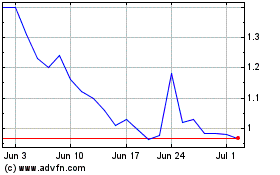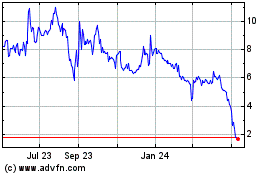Helius Medical Technologies, Inc. (Nasdaq:HSDT) (“Helius” or the
“Company”), a neurotech company focused on delivering a novel
therapeutic neuromodulation approach for balance and gait deficits,
announced today that it has concluded its interaction with the U.S.
Food and Drug Administration (“FDA”) on optimizing the development
plan for its stroke program which aims to evaluate the effects of
cranial-nerve non-invasive neuromodulation (“CN-NINM”) delivered
using PoNS Therapy® on gait and dynamic balance in chronic stroke
survivors. Helius’ registrational program includes two controlled
studies. The clinical program will leverage a randomized,
controlled, double blinded investigator-initiated trial (“IIT”),
led by Dr. Steven Kautz at the Medical University of South Carolina
(“MUSC”) and a Company-sponsored study to enroll approximately 100
subjects. Dr. Kautz’s IIT began enrollment of 60 participants in
September 2023 with the collaboration of Dr. Mark Bowden at Brooks
Rehabilitation as a second site.
“Vetting the registrational program and design of our clinical
studies with the FDA is an important milestone for Helius and
meeting the agency’s expectations will give us the most efficient
path to delivering PoNS Therapy to stroke patients,” said Dr.
Antonella Favit-Van Pelt, Helius’ Chief Medical Officer. “This
development plan, which leverages early study results and
real-world evidence from Canada, allows us to streamline the size,
timeline, and cost of the registrational program and positions
Helius on the best course toward potential FDA authorization under
PoNS’s breakthrough designation for stroke.”
When evaluated in a real-world evidence (RWE) database analysis
of Canadian stroke patients with gait or balance deficit, PoNS
Therapy demonstrated a significant and clinically meaningful
improvement in gait, averaging a 6.74-point improvement in the
functional gait assessment (FGA) score over a 14-wk treatment
period (95% CI: 4.85 to 8.63). Before starting PoNS Therapy, over
93% of patients were considered at risk of falling, as determined
by an FGA<23 score at baseline. After a 14-week treatment
regimen with PoNS, 28% of patients were no longer at fall risk, a
considerable result given that, in routine clinical practice,
rehabilitative physical therapy alone decreases the risk of falling
in only 1-3% of patients. Across all stroke patients in the
database, 69.2% of patients experienced at least a 5-point FGA
improvement, which is larger than the 4.2-point minimal detectable
change usually seen in stroke patients.
“One of our chief objectives is to optimize access to PoNS
Therapy for stroke patients suffering from gait and balance deficit
in North America. We recently announced collaborations with the
University of Montreal and the Quebec Ministry of Health to
evaluate the health economic benefits of PoNS Therapy in these
patients and hope that our development approach will not only save
several millions of dollars in healthcare burden cost but also lead
us on the most expedited pathway toward authorization in the U.S.,
where an estimated 80% of the seven million stroke patients
experience impaired walking,” stated Helius’ President and Chief
Executive Officer, Dane Andreeff. “We are now targeting regulatory
submission by early 2025 with the goal of receiving marketing
authorization later in the same year.”
If authorized to treat stroke in the U.S., PoNS would be
eligible for coverage under the proposed Transitional Coverage of
Emerging Technologies (TCET) pathway, which would expedite Medicare
coverage of certain breakthrough devices by allowing manufacturers
the opportunity for increased premarket engagement with the Centers
for Medicare & Medicaid Services (CMS). Under the new
guidelines, qualifying breakthrough designations would have
temporary coverage within six months after FDA market
authorization. PoNS received breakthrough designations in both
multiple sclerosis and stroke in the United States, potentially
benefiting, with a new indication, an estimated 90% of stroke
patients who are covered by Medicare.
About MUSC
Founded in 1824 in Charleston, South Carolina, MUSC is the
state’s only comprehensive academic health system, with a unique
mission to preserve and optimize human life in South Carolina
through education, research and patient care. Each year, MUSC
educates more than 3,200 students in six colleges – Dental
Medicine, Graduate Studies, Health Professions, Medicine, Nursing
and Pharmacy – and trains more than 900 residents and fellows in
its health system. MUSC brought in more than $298 million in
research funds in fiscal year 2022, leading the state overall in
research funding. MUSC also leads the state in federal and National
Institutes of Health funding with more than $220 million. For
information on academic programs, visit musc.edu.
As the health care system of the Medical University of South
Carolina, MUSC Health is dedicated to delivering the
highest-quality and safest patient care while educating and
training generations of outstanding health care providers and
leaders to serve the people of South Carolina and beyond. Patient
care is provided at 16 hospitals (includes owned and affiliated),
with approximately 2,700 beds and four additional hospital
locations in development; more than 350 telehealth sites and
connectivity to patients’ homes; and nearly 750 care locations
situated in all regions of South Carolina. In 2022, for the eighth
consecutive year, U.S. News & World Report named MUSC Health
University Medical Center in Charleston the No. 1 hospital in South
Carolina. To learn more about clinical patient services, visit
muschealth.org.
MUSC has a total enterprise annual operating budget of $5.1
billion. The nearly 26,000 MUSC family members include world-class
faculty, physicians, specialty providers, scientists, students,
affiliates and care team members who deliver groundbreaking
education, research, and patient care.
About Helius Medical Technologies,
Inc.
Helius Medical Technologies is a leading neurotech company in
the medical device field focused on neurologic deficits using
orally applied technology platform that amplifies the brain’s
ability to engage physiologic compensatory mechanisms and promote
neuroplasticity, improving the lives of people dealing with
neurologic diseases. The Company’s first commercial product is the
Portable Neuromodulation Stimulator. For more information visit
www.heliusmedical.com.
About the PoNS Device and PoNS Therapy
The Portable Neuromodulation Stimulator (PoNS) is an innovative,
non-implantable, orally applied therapy that delivers
neurostimulation through a mouthpiece connected to a controller and
it’s used, primarily at home, with physical rehabilitation
exercise, to improve balance and gait. The PoNS device, which
delivers mild electrical impulses to the tongue, is indicated for
use in the United States as a short-term treatment of gait deficit
due to mild-to-moderate symptoms from multiple sclerosis (“MS”) and
is to be used as an adjunct to a supervised therapeutic exercise
program in patients 22 years of age and over by prescription
only.
PoNS has shown effectiveness in treating gait or balance and a
significant reduction in the risk of falling in stroke patients in
Canada, where it received authorization for sale in three
indications: (i) for use as a short-term treatment (14 weeks) of
gait deficit due to mild and moderate symptoms from stroke and is
to be used in conjunction with physical therapy; (ii) for use as a
short-term treatment (14 weeks) of chronic balance deficit due to
mild-to-moderate traumatic brain injury (“mmTBI”) and is to be used
in conjunction with physical therapy; and (iii) for use as a
short-term treatment (14 weeks) of gait deficit due to mild and
moderate symptoms from MS and is to be used in conjunction with
physical therapy. PoNS is also authorized for sale in Australia for
short term use by healthcare professionals as an adjunct to a
therapeutic exercise program to improve balance and gait. For more
information visit www.ponstherapy.com.
Cautionary Disclaimer Statement
Certain statements in this news release are not based on
historical facts and constitute forward-looking statements or
forward-looking information within the meaning of the U.S. Private
Securities Litigation Reform Act of 1995 and Canadian securities
laws. All statements other than statements of historical fact
included in this news release are forward-looking statements that
involve risks and uncertainties. Forward-looking statements are
often identified by terms such as “believe,” “expect,” “continue,”
“will,” “goal,” “aim” and similar expressions. Such forward-looking
statements include, among others, statements regarding the
Company’s ability to receive authorization for stroke in the U.S.,
the success of the Company’s developmental, regulatory and
commercialization efforts, the Company’s ability to be eligible for
coverage under the proposed Transitional Coverage of Emerging
Technologies (TCET) pathway, and the uses and effectiveness of PoNS
and PoNS Therapy.
There can be no assurance that such statements will prove to be
accurate and actual results and future events could differ
materially from those expressed or implied by such statements.
Important factors that could cause actual results to differ
materially from the Company’s expectations include uncertainties
associated with the Company’s capital requirements to achieve its
business objectives, disruptions in the banking system and
financial markets, the effect of macroeconomic conditions and the
Company’s ability to access capital markets, the Company’s ability
to train physical therapists in the supervision of the use of the
PoNS Treatment, the Company’s ability to secure contracts with
rehabilitation clinics, the Company’s ability to obtain national
Medicare coverage and to obtain a reimbursement code so that the
PoNS device is covered by Medicare and Medicaid, the Company’s
ability to build internal commercial infrastructure, secure state
distribution licenses, build a commercial team and build
relationships with Key Opinion Leaders, neurology experts and
neurorehabilitation centers, market awareness of the PoNS device,
availability of funds, manufacturing, labor shortage and supply
chain risks, our ability to maintain and enforce our intellectual
property rights, clinical trials and the clinical development
process, the product development process, the regulatory submission
review and approval process, our operating costs and use of cash,
and our ability to achieve significant revenues, ongoing government
regulation, and other risks detailed from time to time in the “Risk
Factors” section of the Company’s Annual Report on Form 10-K for
the year ended December 31, 2022, and its other filings with the
United States Securities and Exchange Commission and the Canadian
securities regulators, which can be obtained from either at
www.sec.gov or www.sedar.com.
The reader is cautioned not to place undue reliance on any
forward-looking statement. The forward-looking statements contained
in this news release are made as of the date of this news release
and the Company assumes no obligation to update any forward-looking
statement or to update the reasons why actual results could differ
from such statements except to the extent required by
law.
Investor Relations Contact Lisa M. Wilson,
In-Site Communications, Inc. T: 212-452-2793 E:
lwilson@insitecony.com
Helius Medical Technolog... (NASDAQ:HSDT)
Historical Stock Chart
From Mar 2024 to Apr 2024

Helius Medical Technolog... (NASDAQ:HSDT)
Historical Stock Chart
From Apr 2023 to Apr 2024
